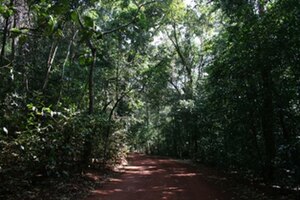Lockerbie Scrub

Lockerbie Scrub is a 230 km2 area of closed forest and woodland, surrounded by open tropical savanna woodland, at the northern tip of the Cape York Peninsula in Far North Queensland, Australia.
Description[edit]
The Scrub consists of lowland rainforest, eucalypt tall open forest and closed eucalypt woodland. The rainforest type represented there is predominantly semi-deciduous notophyll vine forest growing upon a number of different soil types.[1][2] The climate is monsoonal with well-defined wet and dry seasons. Land tenure is mainly Aboriginal (Deed of Grant in Trust) land, with pockets of freehold around the communities of New Mapoon and Bamaga.[3]
Fauna[edit]
Mammals[edit]
Northern quolls, spectacled flying foxes and bare-backed fruit bats occur in the Lockerbie Scrub.[3]
Birds[edit]

Some 158 km2 of the Lockerbie Scrub has been identified by BirdLife International as an Important Bird Area (IBA) because it is a significant migratory bottleneck for spangled drongos and rainbow bee-eaters, as well as supporting populations of lovely fairywrens and yellow-spotted honeyeaters.[4]
Also present in the area are several birds whose Australian range is limited to the Cape York Peninsula, including palm cockatoos, yellow-billed kingfishers, Papuan pittas, trumpet manucodes, magnificent riflebirds, fawn-breasted bowerbirds, northern scrub robins, yellow-legged flycatchers, tropical scrubwrens and frill-necked monarchs. The endangered southern cassowary was recorded in Lockerbie Scrub in 1986 but is now probably extinct there. Bush stone-curlews, silver-crowned friarbirds and yellow honeyeaters have been recorded on rare occasions. Graceful honeyeaters are common. White-streaked honeyeaters are present.[3]
References[edit]
- ^ Abrahams, H.; Mulvaney, M.; Glasco, D.; & Bugg, A. (1995). Areas of Conservation Significance on Cape York Peninsula."CYPLUS LUP Areas of Conservation Significance on Cape York Peninsula: Chapter 16". Archived from the original on 15 September 2007. Retrieved 9 January 2008. accessed 9 January 2008
- ^ Stanton, J.P.; Fell, David. G. (2005). "The rainforests of Cape York Peninsula". Rainforest CRC. pp. 4, 163, 164, 165, 166 – via National Library of Australia.
- ^ a b c BirdLife International. (2011). Important Bird Areas factsheet: Lockerbie Scrub. Downloaded from http://www.birdlife.org on 07/08/2011.
- ^ "IBA: Lockerbie Scrub". Birdata. Birds Australia. Archived from the original on 6 July 2011. Retrieved 7 August 2011.
10°48′07″S 142°28′31″E / 10.80194°S 142.47528°E
